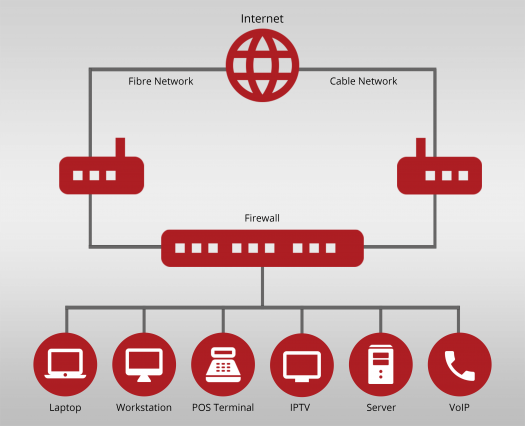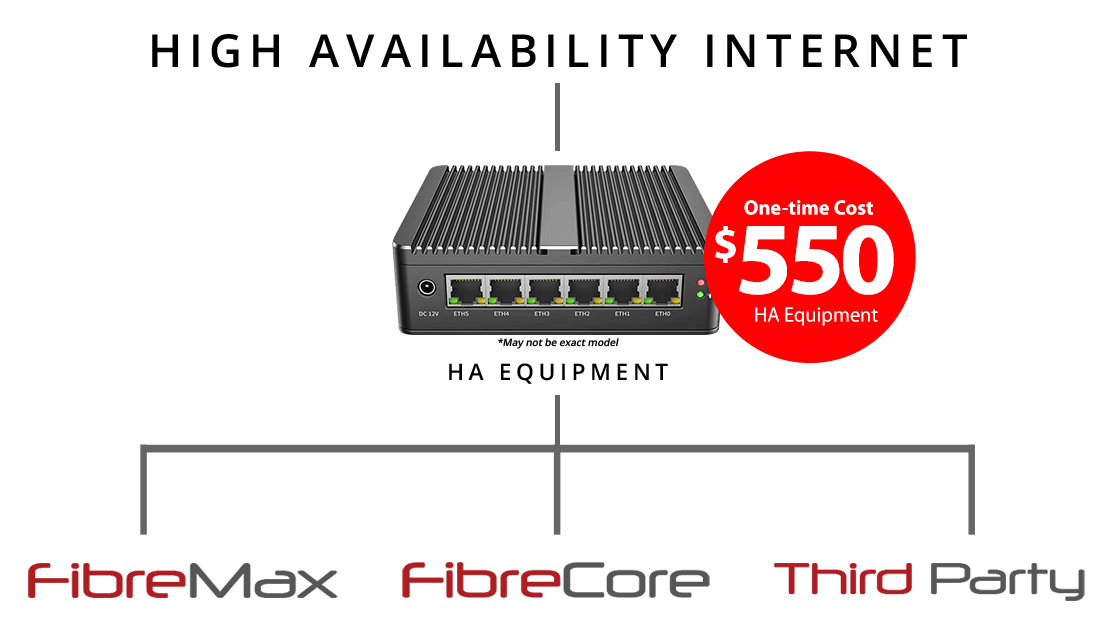High Availability Internet
Always Online and Guaranteed Uptime
High availability internet refers to systems proven to be reliable enough to run continually and sustainably. High availability is often characterized by redundancy, having been rigorously tested, and systems’ ability to highly withstand periods of degraded quality and performance for a significant amount of time without disruption.

High availability internet delivers businesses with efficient, economical, reliable access to critical applications -giving your business a competitive edge. Because of the costs associated with downtime, it’s essential to plan for high availability ahead before beginning production deployment. You need to understand the applications running in your environment, storage technology, and how much latency must be considered so that you can determine and recommend the best available solution.
Benefits of High Availability Internet
Reliability
Enables you to stay connected even when wired connections are not possible.
Cost control
Control disruptions that can affect or ruin sales and revenue because of tedious downtime.
Continuity
Ensure successful communication can still be maintained even when wirelines are disrupted.
Flexibility
Offer and build primary access paths to retail stores, triage sites, branches and banks.
FREQUENTLY ASKED QUESTIONS
Why is High Availability Internet Important?
High availability internet helps reduce the disruption of servers caused by unexpected occurrences. Even the most robust software and systems will sometimes fail in the face of emergencies. And that is why it is important to be prepared for any eventuality that might cause your server to go offline.
High Availability Architecture
Crucially, systems need to be able to handle high loads and large volumes of traffic. Minimizing downtime and identifying potential failure points are two equally important steps. This is where high-availability load balancing comes in handy. It’s a key component that responds appropriately and allows for traffic to be scaled up as needed especially when it spikes. Usually, this involves developing software architecture to work around hardware limitations.
This is a process where servers are set up to transfer or take turn responsibility if the first one is unavailable or when necessary. Each piece of hardware is tested for its durability including scaling the interval between downtime.
How High Availability Internet Works
It begins by identifying weaknesses in the operating system’s infrastructure that could cause it to fail and eliminating these flaws to achieve high availability. Any condition that would cause any critical service necessary for normal operations to disrupt if it were not available is considered here.
There may be independent components in your infrastructure that aren’t critical to the system’s overall function. One important question is whether you have the ability to detect any data loss or other system failures, and if so, how quickly can such failures be addressed?
Another factor is determining whether you have redundant system components that are configured in such a way that can perform or take over the same functions and compensate for any weaknesses.
Which High Availability Products Do You Need?
High availability products help ensure that applications keep running in the face of such problems as hardware failure and network disruption, however it takes more to achieve max uptime. Important elements include data quality, environmental conditions (such as degree of humidity), hardware resilience (how well a computer system can function when there is no power available), and software that doesn’t depend too much on specific hardware.
Data can be lost or become corrupted/inaccurate in many ways. Any system that is highly available provides consistent, uninterrupted protection for data and systems regardless of the cause.
Highly available hardware includes servers and components that can continue operating effectively in the face of failures and recover well from power outages.
A high availability firewall is another part of an HA system. Multiple application firewalls (also called web application firewalls) are deployed at various points in networks and systems so that if one fails, another will continue to process data.
Because failures are possible in any networked system, networks and software stacks must be designed to withstand failures – because even the best-run businesses experience problems.
What is the Difference Between High Availability and Redundancy?
Redundancy alone is not enough to ensure high availability. A system also needs mechanisms to detect failures so that appropriate action can be taken.
The ability to perform tests for high availability and take corrective action when any of a stack’s components fail is crucial.
Both top-to-bottom and distributed approaches to high availability can succeed also hardware and software-based solutions are also effective at minimizing downtime.
Redundancy is a hardware-based solution. Moreover, high availability strategies are nearly always implemented with software.
High Availability vs Fault Tolerance
High availability and fault tolerance are two ways of making and guaranteeing a system more resistant in the event of failure or downtime. However, fault-tolerant as compared with high availability strategies both aim to keep applications running continuously, their goals differ in accomplishing that goal.
Fault-tolerance computing relies on complete hardware redundancy. Multiple systems work together to ensure the network continues to operate even if one component fails, duplicating applications and instructions executed simultaneously. In the event the primary system fails, another should take over seamlessly to ensure no downtime for users.
Fault-tolerant computing requires specialized hardware. The system needs to be able to distinguish component failures instantly, so other parts of the system can continue functioning.
In addition to its other advantages, this system preserves the memory and data of its programs which is highly beneficial. Moreover, for networks and systems that are more complex, it may take longer to adapt to failure. Additionally, when software malfunctions cause a system to crash, the failure can sometimes propagate throughout redundant systems that are operating in tandem—causing complete failure of the entire system.
A high availability solution reduces downtime on servers by relying on software rather than hardware-based. Rather than using physical hardware for redundancy, a high availability cluster tracks down a set of servers all together.
These high availability servers have the ability to monitor each other and possess failover capabilities. If the primary server experiences problems, only one backup server needs to identify them in order for recovery actions to take place. It can launch the application that caused the crash and attempt to restart it.
High availability systems can get back rapidly but they also carry the risk in the time it takes for the system to reboot. Fault-tolerant systems can protect your business against equipment failure (which can be very costly) and do not protect against software failure.
Therefore, businesses in most sectors—especially software-driven ones—will benefit from a high availability architecture. It is highly economical than a fault-tolerant system, which cannot handle software issues as well.
High Availability vs Disaster Recovery
Likewise, it is also important to distinguish and clarify the difference between high availability and disaster recovery here. Disaster recovery (DR), as it sounds, is a plan that enables critical operations/systems back up and running after natural disasters or other unforeseen events.
But if your system is highly available and fault-tolerant, engaging in such planning may be unnecessary.
DR is designed to help resume critical functions and gets it running again as soon as possible after a serious problem occurs such as a major outage or disaster. High availability concentrates on the most common causes of failures (such as a failing component or server). A disaster recovery plan may be used to cope with the loss of an entire region, although both are related.
What is a Highly Available Load Balancer?
Availability is expressed as a percentage of uptime—that is, the amount of time for which your system can be accessed. There are two ways to make a highly available load balancer operate at peak performance: you can deploy a single node or across a cluster. A single node deployment uses a single load-balancing controller to run all administrative functions and gather/process analytics data. Additional nodes are used in a high availability load-balancing cluster to maximize performance for CPU-intensive analytics functions and provide redundancy for the load balancing controller.
AEBC Offer Solutions for High Availability in Load Balancing?
AEBC has developed a solution for high availability load balancing that can be molded into different configurations in various modes for a variety of purposes.
AEBC Controller High Availability provides redundancy at the node level for AEBC Controllers. One AEBC Controller is deployed as the leader node, with two additional nodes added in a follower role.
AEBC Service Engine High Availability provides redundant service-engine-level within a service engine group. The Service Engines share information with each other, allowing them to monitor and take action when needed on another engine’s behalf.
When a service engine within the group fails, high availability kicks in to heal (restore) the failure and compensate for reduced site capacity.
Redundancy
A high-availability IT infrastructure includes hardware, software, and application redundancy as well as data redundancy. In a high-availability cluster, redundant IT components such as servers or databases can perform the same tasks, meaning it’s less likely to crash.
Redundancy is also an important component of fault tolerance—a complex system’s ability to continue operating even when faults occur. Fault-tolerant systems are critical for ensuring high availability and disaster recovery, which we’ll explore in more detail later on.
Replication
In order to achieve high availability, replicating data is crucial. It is necessary for data to be replicated onto the same nodes in a cluster and shared between them.
Each node must work together, communicate with each other and share information in order to provide optimal service so that any time the server or network device fails another can take its place.
To ensure high availability and business continuity, data can be replicated among clusters in case the data center goes down.
Failover
In a high-availability cluster, failover takes place when processes carried out by the primary component fail or is unable to complete, it’s completed by another process where it moves up to a backup component. It is best practice for high availability and disaster recovery to maintain a failover system that’s located off-site.
Critical primary systems can be monitored by IT administrators that can efficiently reroute traffic when the primary system becomes overloaded or fails to the failover system.
Fault tolerance
Business continuity relies on several factors, including high availability and disaster recovery. Together, they can be used in tandem to help organizations build high levels of fault tolerance, which refers to a system’s ability—even if multiple hardware or software components fail—to keep operating without interruption.
Fault tolerance strives for no downtime while high availability focuses on minimizing downtime in the event of failure. A high-availability system designed with 99.999% uptime expects to have 5 minutes of downtime per year.
In contrast to high availability, fault tolerance does not prioritize delivering high-quality performance. Fault-tolerance design enables mission-critical applications to continue functioning during periods of downtime.
Fault tolerance is an approach that makes sure uptime that needs backing up entire hardware and software systems and power supplies, making it more expensive than high availability. High availability systems do not need physical components duplicated.
High availability and fault tolerance are complementary in that, together, they support the prevention, detection, and recovery of IT disasters. Most business continuity strategies include measures designed to keep the company running even in the face of severe problems and that involves high availability, fault tolerance, and disaster recovery. An organization or business can maintain crucial operations and provide critical support to users when they most need it through these strategies. These strategies minimize the impact of any type of critical IT failure, be it small or large.




